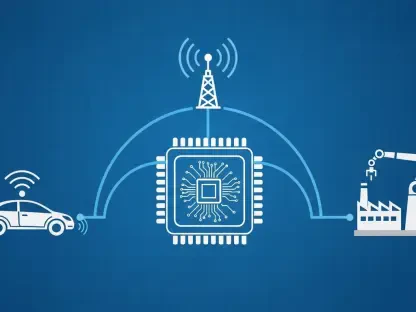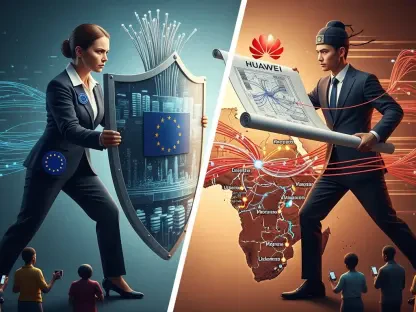Setting the Stage for Next-Gen Connectivity
In an era where digital transformation dictates the pace of global progress, the rollout of 5G technology stands as a cornerstone for innovation across industries, from healthcare to smart infrastructure. Huawei, a titan in the telecommunications realm, has positioned itself at the forefront of this revolution, offering solutions that promise unprecedented data speeds and connectivity. With billions of devices expected to connect through 5G networks in the coming years, the stakes for reliable and secure infrastructure have never been higher. This review delves into Huawei’s 5G technology, examining its technical prowess, real-world impact, and the complex challenges it faces in a landscape marked by geopolitical tensions.
Overview of Huawei’s 5G Solutions
Huawei has emerged as a leading provider of 5G infrastructure, shaping the future of telecommunications with its comprehensive portfolio of hardware and software solutions. The company’s technology is built on advanced principles of high-speed data transmission, low latency, and massive device connectivity, catering to the demands of modern networks. Its role extends beyond mere equipment supply, influencing global standards and deployment strategies for next-generation connectivity.
However, Huawei’s prominence is not without controversy. Security concerns and geopolitical debates, particularly in Western markets, have cast a shadow over its operations. Allegations of potential espionage risks tied to the Chinese government have led to scrutiny and restrictions in several regions, despite the company’s repeated denials. This dynamic shapes the context in which Huawei’s 5G technology is evaluated, balancing technical innovation against external pressures.
Core Features and Technical Innovations
Advanced Radio Access Network (RAN) Capabilities
Huawei’s 5G Radio Access Network technology, centered around its gNodeB base stations, represents a leap forward in enabling high-speed data transfer and supporting vast numbers of connected devices. These base stations are designed to deliver exceptional bandwidth, often exceeding traditional 4G networks by multiples, while slashing latency to mere milliseconds. Such performance is critical for applications like autonomous vehicles and real-time industrial automation.
The efficiency of Huawei’s RAN solutions lies in their ability to manage dense network traffic, a necessity in urban environments where device concentration is high. By leveraging advanced antenna technologies and spectrum optimization, these systems ensure robust connectivity even under heavy load. This capability underscores Huawei’s technical edge in addressing the scalability demands of modern telecommunications.
Robust Core Network Architecture
At the heart of Huawei’s 5G ecosystem is its core network architecture, a software-driven framework built for flexibility and scalability. This system orchestrates critical network functions, from data routing to security protocols, ensuring seamless operation across diverse applications. Its cloud-native design allows for rapid updates and customization, adapting to evolving industry needs with ease.
A key strength of this architecture is its support for network slicing, which enables operators to create virtual networks tailored to specific use cases, such as ultra-reliable low-latency communication for emergency services. This adaptability positions Huawei’s core solutions as vital for complex, multi-sector deployments. Additionally, the integration of artificial intelligence enhances network management, optimizing performance in real time.
Recent Developments and Industry Shifts
Huawei continues to innovate within the 5G space, rolling out enhancements in both hardware efficiency and software capabilities to maintain a competitive edge. Recent advancements include more energy-efficient base stations and improved algorithms for traffic management, addressing growing demands for sustainability in tech infrastructure. These updates reflect a commitment to aligning with global trends toward greener telecommunications.
Industry behavior is also shifting, with a notable push toward Open RAN architectures that prioritize interoperability among vendors. While Huawei does not participate in the Open RAN Alliance, this trend toward vendor diversification impacts its market strategy, as operators seek to reduce dependency on single suppliers. Such movements are partly driven by regulatory pressures in various regions, aiming for more flexible network ecosystems.
Geopolitical tensions further complicate Huawei’s trajectory, especially in markets like Germany, where regulatory bodies are reevaluating the classification of 5G components as critical infrastructure. Proposals to extend restrictions from core networks to RAN elements signal a tougher stance, influencing Huawei’s market access. These developments highlight the intersection of technology and policy in shaping industry dynamics.
Real-World Applications and Use Cases
Huawei’s 5G technology has found practical deployment across multiple sectors, demonstrating its capacity to drive efficiency and innovation. In telecommunications, operators in regions like Asia and parts of Europe rely on Huawei’s infrastructure to deliver high-speed mobile services, supporting millions of users with enhanced browsing and streaming experiences. These implementations showcase the technology’s ability to handle large-scale consumer demands.
Beyond telecom, Huawei’s solutions power smart city initiatives, enabling real-time data collection for traffic management and public safety systems. In healthcare, 5G facilitates remote surgeries through ultra-low latency connections, transforming patient care in underserved areas. Manufacturing also benefits, with factories leveraging Huawei’s networks for automated production lines, improving precision and reducing downtime through connected machinery.
However, adoption is not universal. Certain regions and operators, influenced by security concerns, have restricted or phased out Huawei’s equipment, opting for alternative vendors. This patchwork of acceptance and restriction illustrates the varied landscape in which the technology operates, balancing proven benefits against perceived risks in different markets.
Challenges and Limitations in Deployment
The deployment of Huawei’s 5G technology faces significant hurdles, primarily rooted in security concerns that have led to widespread debate. Fears of potential espionage or interference, though unproven, have prompted regulatory bans in key markets, with countries like Germany considering stringent measures to classify all 5G components as critical. Such policies threaten to limit Huawei’s footprint in major economies.
Economic challenges also loom large, as replacing Huawei’s equipment imposes substantial costs on operators. Estimates suggest billions in expenses for full transitions, a burden that could slow 5G rollouts in affected regions. Additionally, potential retaliatory actions from China against foreign industries add a geopolitical layer to the economic calculus, complicating decision-making for policymakers and companies alike.
Huawei has responded by emphasizing transparency and investing in cybersecurity measures to counter perceptions of risk. Efforts to collaborate with international standards bodies aim to rebuild trust, though skepticism persists in some quarters. Technical limitations, such as compatibility with emerging Open RAN frameworks, further challenge the company’s ability to adapt to evolving industry preferences, necessitating strategic adjustments.
Future Prospects of Huawei 5G Technology
Looking ahead, Huawei’s 5G technology holds potential for further innovation, with anticipated developments in areas like edge computing integration and enhanced network security features. These advancements could strengthen its position in markets prioritizing cutting-edge solutions, provided the company navigates regulatory landscapes effectively. Strategic partnerships and localized production may offer pathways to mitigate restrictions.
Market strategies will likely focus on diversifying offerings and addressing security concerns head-on, possibly through third-party audits or open-source initiatives to demonstrate reliability. As global telecommunications evolve, Huawei might adapt to trends like vendor diversification by tailoring solutions for hybrid network environments, ensuring relevance despite competitive pressures.
The long-term impact on the industry hinges on how Huawei balances technological leadership with geopolitical realities. If successful in rebuilding trust, its influence could grow in shaping 5G standards over the next few years, from 2025 onward. However, persistent regulatory barriers may confine its growth to specific regions, reshaping the global balance of telecom infrastructure providers.
Final Assessment and Next Steps
Reflecting on the comprehensive evaluation, Huawei’s 5G technology demonstrates remarkable strengths in performance and scalability, positioning it as a formidable player in telecommunications. Its advanced RAN and core network capabilities prove instrumental in driving real-world applications across diverse sectors. Yet, the challenges of security perceptions and regulatory constraints cast a shadow over its widespread adoption, particularly in Western markets.
Moving forward, a critical step for stakeholders involves exploring collaborative frameworks to address security concerns, potentially through independent certifications that validate Huawei’s equipment integrity. Operators who face replacement costs benefit from phased transitions and diversified vendor strategies to minimize disruption. For Huawei, investing in alignment with global trends like Open RAN offers a chance to regain market trust. These actionable measures pave the way for a balanced approach, ensuring that technological innovation thrives alongside necessary safeguards in the evolving 5G landscape.









